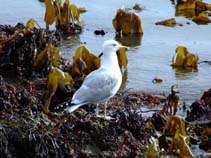Larus argentatus Pontoppidan, 1763
Herring gull
Classification / Names Common names | Synonyms | CoL | ITIS | WoRMS
Aves | Charadriiformes | Laridae
Environment: milieu / climate zone / depth range / distribution range Ecology
Others; freshwater; brackish. Tropical; 84°N - 36°S, 130°W - 128°E (Ref. 124582)
Distribution Countries | FAO areas | Ecosystems | Occurrences | Introductions
Indo-Pacific, Atlantic Ocean and the Arctic. Tropical to polar.
Length at first maturity / Size / Weight / Age
Maturity: Lm ? range ? - ? cm Max length : 66.0 cm TL male/unsexed; (Ref. 8812); max. published weight: 1.1 kg (Ref. 356)
Short description Morphology
Life cycle and mating behavior Maturity | Reproduction | Spawning | Eggs | Fecundity | Larvae
Main reference
References | Coordinator | Collaborators
Stiles, F.G. 1984 Status and conservation of seabirds in Costa Rican waters. In Croxall, J.P., Evans, P.G.H. and Schreiber, R.W. (eds.), Status and Conservation of the World's Seabirds. ICBP Technical Publication 2:223-229. (Ref. 5856)
IUCN Red List Status
(Ref. 130435: Version 2025-1)
CITES status (Ref. 108899)
CMS (Ref. 116361)
Threat to humans
Human uses
| FishSource |
Tools
More information
Maturity
Fecundity
Spawning
Eggs
Egg development
Larvae
Internet sources
BHL | BOLD Systems | CISTI | DiscoverLife | FAO(Publication : search) | Fishipedia | GenBank (genome, nucleotide) | GloBI | Gomexsi | Google Books | Google Scholar | Google | PubMed | Tree of Life | Wikipedia (Go, Search) | Zoological Record



